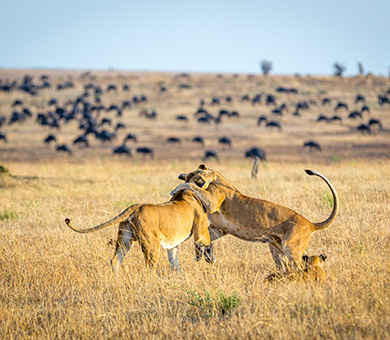The wildebeest migration spread out along areas of Serengeti National Park. They can be found around Naabi Hill and Gol Kopjes and Ndutu and moving northwards into the area south of Grumeti River and Seronera.
Serengeti National Park
Moru Kopjes:
Due to the high moisture levels at Moru Kopjes, access is predominantly limited to the main roads. Most game drives take place in the central part of the Serengeti and Togoro Plains. When conditions permit, we also explore Gol Kopjes and Barafu Kopjes.
Wildlife Updates:
Lions: Sightings have been frequent between Gol Kopjes and Barafu Kopjes, as well as in the Togoro area. Occasionally, lions are spotted climbing trees in the central Serengeti where the grass is exceptionally tall.
Leopards: These elusive cats are most often seen en route from Serena Lodge to Seronera, and intermittently around the central Serengeti, Togoro, Nanyukie, and Masai Kopjes.
Cheetahs: Regular sightings occur at Gol Kopjes, Barafu Kopjes, and Ndutu.
Interesting Sightings:
Our recent highlights include observing tree-climbing lions and witnessing cheetahs on the hunt. The migration spectacle continues in the vast plains stretching between Ngorongoro and Naabi Hill, including the Ndutu area. The Seronera and Retima Hippo Pools remain accessible throughout the rainy or wet season, offering consistent viewing opportunities.
Ngorongoro Conservation Area
Lake Magadi, at the centre of the Ngorongoro Crater, has a very good level and there are reports of flamingos in the area just now. With more than 30,000 mammals including all of the big five, and tens of thousands of birds, game viewing is always exception in the crater.
Lake Manyara National Park
Lake Manyara National Park is at a perfect level for game viewing. Large troops of baboons have been spoted, providing a facinating
The Forest dwellers like blue monkeys and the endemic silvery cheeked hornbill are also very active because this time of plenty of food. There are regular sightings of tree climbing lions and the occasional leopard is reported in the park
Lake Manyara also attracts plenty of animals from the nearby Tarangire National Park through the Kwa Kuchinja Migration corridor.
Tarangire National Park
Animal Movements and Habitats: As is typical, the wildebeest and zebras have dispersed, migrating towards the southern, eastern, and northern regions. Resident animals, including elephants, buffalo, giraffes, waterbucks, lions, and leopards, remain in the area.
Noteworthy Sightings: Recent wildlife observations have been exciting, featuring elephants, several tree-climbing lions, leopard sightings, and occasional cheetahs. The main road from the Main Gate up to Silaleh Swamp and around the Kuro Rangers post offers excellent opportunities for game drives, although caution is advised during rain.
Current Viewing Conditions: Despite the rainy conditions, the viewing experience has been exceptional. Sightings have included all of the “Big Five,” the wildebeest migration, and a variety of general game. Visitor satisfaction is high, and there are notably few vehicles in the area, enhancing the viewing experience.
Nyerere National Park and other Southern Parks
This is the time of year when the airstrips are closed, as are most of the lodges and camps.
Masai Mara National Reserve
After recent heavy rains in the Masai Mara, conditions are stabilizing. The abundant rainfall has led to lush, fresh grass, providing ample nourishment for the herbivores. Consequently, predators such as lions, leopards, and cheetahs are more frequently spotted as they await opportunities to hunt their next meal.
Samburu National Reserve
Samburu National Reserve as well as Buffalo Springs and Shaba have seen an amazing transition from the arid feel it had last year to a new regeneration of life and with it, some great game viewing opportunities.
Amboseli National Park
Amboseli National Park, renowned for its stunning views of Mount Kilimanjaro and its vast elephant herds, offers a spectacular game viewing experience. The park’s relatively flat and open terrain provides excellent visibility for observing wildlife, including lions, cheetahs, giraffes, and over 400 species of birds. The wetlands, fed by the underground rivers from Kilimanjaro’s ice cap, support a rich diversity of animals and plant life throughout the year. Visitors are particularly drawn to Amboseli for its elephant populations, where these majestic creatures can be seen in large family groups, often led by matriarchs. The backdrop of the snow-capped Kilimanjaro creates a breathtaking setting for wildlife photography and unforgettable safari moments.
Lake Nakuru National Park
Lake Nakuru National Park is a great place for viewing rhinoceros as this video shows as nearby Lake Elementaita is teeming with flamingo.

